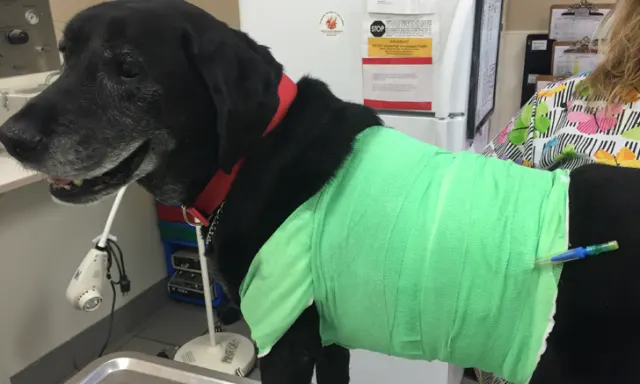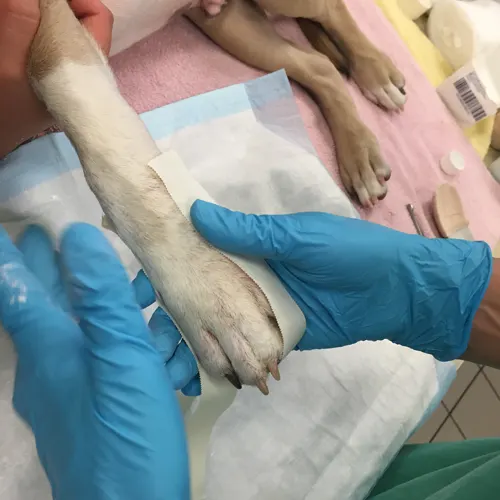Image Gallery: Bandage Application
Jennifer A. Grady-Holmes, CVT, VTS (ECC), Oradell Animal Hospital, Paramus, New Jersey

Bandages are used to control the wound environment in open or closed wounds; provide cleanliness, comfort, pressure, immobilization, and stabilization; and promote healing.1 Although bandaging techniques vary slightly depending on the site and bandage purpose, basic placement principles remain the same.
Bandages are composed of 3 layers:
Primary, or contact layer
Secondary, or intermediate layer
Outer, or tertiary layer1,2
The primary layer contacts the wound surface and may consist of an adherent or nonadherent dressing. Adherent dressings, such as wet-to-dry bandages, are used to assist with wound debridement and absorption of wound exudate. Sugar bandages have been incorporated more recently to treat infected wounds and stimulate granulation tissue.1 Vacuum-assisted closure (VAC therapy) is another alternative method to promote healing in large open wounds and promote granulation tissue. Nonadherent dressings are generally used for closed wounds and minor lacerations.1
The secondary layer consists of a thick absorbent layer that provides support and absorbs fluid.1,2
The outer layer holds the layers in place, covers the bandage, and protects the wound from contamination. Monitoring for “strike-through,” when the wound exudate soaks through to the outer layer, is necessary to avoid contamination.2 When strike-through occurs, dirt and bacteria can readily pass through the bandage layers to the wound; therefore, all bandages must be kept clean and dry and changed regularly or when saturation is noted.1,2 Monitoring for edema or discomfort is also important, because bandages may slip, become displaced or restrictive, and create excessive pressure.2
Extremity bandages are generally used to stabilize or immobilize bones and joints or protect wounds or incisions. When bandaging long bones, proximal and distal joints should be incorporated into the bandage. When bandaging joints, proximal and distal long bones and often proximal joints are incorporated to avoid slipping.

Figure 1 Prepare the Patient. The limb should be as clean and dry as possible before placing the bandage. Using 1-in porous tape, place 2 tape strips, or stirrups, on the medial and lateral or dorsal and ventral paw surfaces to assist with bandage stabilization. Stirrups should extend beyond the limb and avoid contact with the pad.
This article originally appeared in the October 2016 web issue of Veterinary Team Brief.